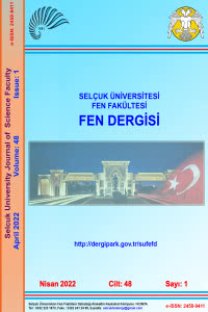DETERMINATION OF MATERIAL RESPONSE AND OPTIMIZATION OF JOHNSON-COOK DAMAGE PARAMETERS OF ALUMINIUM 7075 ALLOY
Alüminyum 7075 Alaşiminin Malzeme Davranişinin Tespiti ve Johnson-Cook Hasar Parametrelerinin Optimizasyonu
___
Binder, M., Klocke, F., Lung, D., 2015, "Tool Wear Simulation of Complex Shaped Coated Cutting Tools", Wear, Vol. 330–331, pp. 600-607.Bobbili, R., Ramakrishna, B., Madhu, V., Gogia, A. K., 2015, "Prediction of Flow Stress of 7017 Aluminium Alloy under High Strain Rate Compression at Elevated Temperatures", Defence Technology, Vol. 11, pp. 93–98.
Bobbili, R., Madhu, V., 2016, "Effect of Strain Rate and Stress Triaxiality on Tensile Behavior of Titanium Alloy Ti-10-2-3 at Elevated Temperatures", Materials Science and Engineering A, Vol. 667, pp. 33– 41.
Bobbili, R., Paman, A., Madhu, V., 2016, "High Strain Rate Tensile Behavior of Al-4.8Cu-1.2Mg Alloy", Materials Science and Engineering A, Vol. 651, pp. 753–762.
Børvik, T., Hopperstad, O. S., Dey, S., Pizzinato, E. V., Langseth, M., Albertini, C., 2005, "Strength and Ductility of Weldox 460 E Steel at High Strain Rates, Elevated Temperatures and Various Stress Triaxialities", Engineering Fracture Mechanics, Vol. 72, pp. 1071–1087.
Brar, N. S., Joshi, V. S., 2012, "Anisotropic Effects on Constitutive Model Parameters of Aluminum Alloys", AIP Conference Proceedings, Vol. 1426 (1), pp. 72–75.
Brar, N. S., Joshi, V. S., Harris, B. W., 2009, "Constitutive Model Constants for Al7075-T651 and Al7075- T6", AIP Conference Proceedings, Vol. 1195 (1), pp. 945–948.
Cai, M.-C., Niu, L.-S., Ma, X.-F., Shi, H.-J., 2010, "A Constitutive Description of the Strain Rate and Temperature Effects on the Mechanical Behavior of Materials", Mechanics of Materials, Vol. 42 (8), pp. 774–781.
Chen, G., Ren, C., Qin, X., Li, J., 2015, "Temperature Dependent Work Hardening in Ti–6Al–4V Alloy Over Large Temperature and Strain Rate Ranges: Experiments and Constitutive Modeling", Materials & Design, Vol. 83, pp. 598–610.
Chocron, S., Erice, B., Anderson, C. E., 2011, "A New Plasticity and Failure Model for Ballistic Application", International Journal of Impact Engineering, Vol. 38 (8–9), pp. 755–764.
Choung, J., Nam, W., Lee, D., Song, C. Y., 2014, "Failure Strain Formulation via Average Stress Triaxiality of an EH36 High Strength Steel", Ocean Engineering, Vol. 91, pp. 218–226.
Hirsch, J., Al-Samman, T., 2013, "Superior Light Metals by Texture Engineering: Optimized Aluminum and Magnesium Alloys for Automotive Applications", Acta Materialia, Vol. 61 (3), pp. 818–843.
Keshavarz, A., Ghajar, R., Mirone, G., 2014, "A New Experimental Failure Model Based on Triaxiality Factor and Lode Angle for X-100 Pipeline Steel", International Journal of Mechanical Sciences, Vol. 80, pp. 175–182.
Kupchella, R., Stowe, D., Xiao, X., Algoso, A., Cogar, J., 2015, "Incorporation of Material Variability in the Johnson Cook Model", Procedia Engineering, Vol. 103, pp. 318–325.
Senthil, K., Iqbal, M. A., Chandel, P. S., Gupta, N., 2017, "Study of the Constitutive Behavior of 7075-T651 Aluminum Alloy", International Journal of Impact Engineering, Vol. 108, pp. 171-190.
Thepsonthi, T., Özel, T., 2015, "3-D Finite Element Process Simulation of Micro-end Milling Ti-6Al-4V Titanium Alloy: Experimental Validations on Chip Flow and Tool Wear", Journal of Materials Processing Technology, Vol. 221, pp. 128–145.
Valoppi, B., Bruschi, S., Ghiotti, A., Shivpuri, R., 2017, "Johnson-Cook Based Criterion Incorporating Stress Triaxiality and Deviatoric Effect for Predicting Elevated Temperature Ductility of Titanium Alloy Sheets", International Journal of Mechanical Sciences, Vol. 123 (01), pp. 94–105.
Wang, B., Liu, Z., 2016, "Evaluation on Fracture Locus of Serrated Chip Generation with Stress Triaxiality in High Speed Machining of Ti6Al4V", Materials and Design, Vol. 98, pp. 68–78.
Yuan, Z., Li, F., Qiao, H., Xiao, M., Cai, J., Li, J., 2013, "A Modified Constitutive Equation for Elevated Temperature Flow Behavior of Ti-6Al-4V Alloy Based on Double Multiple Nonlinear Regression", Materials Science and Engineering A, Vol. 578, pp. 260–270.
Zhang, D. N., Shangguan, Q. Q., Xie, C. J., Liu, F., 2015, "A Modified Johnson-Cook Model of Dynamic Tensile Behaviors for 7075-T6 Aluminum Alloy", Journal of Alloys and Compounds, Vol. 619, pp. 186–194.
Zhou, Z., Kuwamura, H., Nishida, A., 2011, "Effect of Micro Voids on Stress Triaxiality-Plastic Strain States of Notched Steels", Procedia Engineering, Vol. 10, pp. 1433–1439.
- ISSN: 2147-9364
- Yayın Aralığı: 2
- Başlangıç: 2013
- Yayıncı: Selçuk Üniversitesi Mühendislik Fakültesi
PVP-AŞILANMIŞ NiFe2O4 NANO PARÇACIKLARININ YÜZEY POLİMERİZASYONU TEKNİĞİ İLE SENTEZİ
SEMA VURAL, Aysel ALPHAN, SÜLEYMAN KÖYTEPE, TURGAY SEÇKİN
TÜRKAN ALTUN, ŞERİFE PARLAYICI
Betonarme Kirişlerin Basit ve Ankastre Mesnet Koşullarında Kesme Davranışının Araştırılması
PENCERE BOŞLUKLU PERDE DUVARLA GÜÇLENDİRİLMİŞ 1/3 ÖLÇEKLİ BETONARME ÇERÇEVELERİN DAVRANIŞI
FATİH SÜLEYMAN BALIK, FATİH BAHADIR, MEHMET KAMANLI, HASAN HÜSNÜ KORKMAZ, ALPTUĞ ÜNAL, M. Yaşar KALTAKCI
MEGA ŞEHİR İSTANBUL'UN FIRTINALARININ ARAŞTIRILMASI
Emrah Tuncay ÖZDEMİR, Emrah Tuncay ÖZDEMİR
FPGA TABANLI DİJİTAL HABERLEŞME SİSTEMLERİNİN SYSTEM GENERATOR ARACI İLE ANALİZİ
İBRAHİM IŞIK, MEHMET EMİN TAĞLUK
